This weekend’s habitat event was helping install wildlife-friendly native plants to create a beginning wildlife garden at the Austin Groups for the Elderly building, known locally as the AGE building. This non-profit organization “empowers caregivers, the elderly and their families through education, advocacy, resources and support” and is a daytime care and resource facility for older members of our community.

Habitat volunteers from the City of Austin, Travis Audubon, and NWF, along with friends and family and AGE staff, got right to work. The first task was scraping out clover and grass from the future beds.

Next, volunteers watered the soil a bit, then placed a carefully arranged layer of cardboard, which also was made wet.


On top of that, we layered soil where necessary, and topped it all with single-shred mulch, kept thin under the trees. This method of lawn reduction is effective and remarkably simple.

The final step was adding plants, including Mexican Buckeye, Shrubby Boneset, Texas Mulberry, Evergreen Sumac, Turk’s Cap, Crossvine, and others. The plants were small, but small is all it takes!
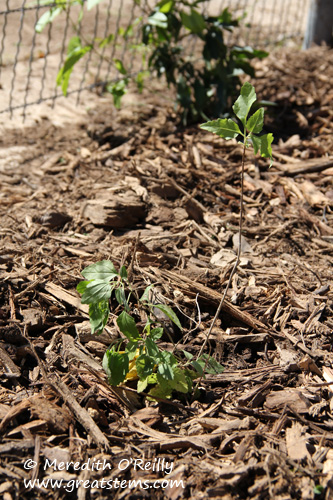 The garden is a favorite sitting area for many AGE members, and the new habitat will attract many butterflies and birds for visitors’ viewing pleasure. The building also houses our Travis Audubon office — so we’re extra glad to have a new habitat right outside!
The garden is a favorite sitting area for many AGE members, and the new habitat will attract many butterflies and birds for visitors’ viewing pleasure. The building also houses our Travis Audubon office — so we’re extra glad to have a new habitat right outside!
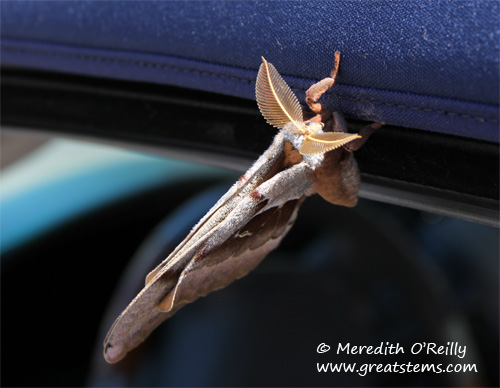 As we were getting ready to leave, my husband called me over to see a creature hanging upside-down from the car of a volunteer. It turned out to be a gorgeous Lepidopteran.
As we were getting ready to leave, my husband called me over to see a creature hanging upside-down from the car of a volunteer. It turned out to be a gorgeous Lepidopteran.
The volunteer was quite concerned, and to be honest, from a distance it really did look like a bat was hanging from his window. But I rushed right over to rescue it, and it proved to be a stunning, yet frail, Polyphemus moth. Those bushy antennae you see are an indication that this moth also happened to be male.
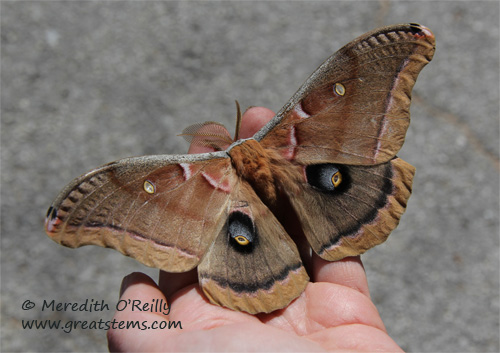
There are a number of threats to this beautiful species, but at least they have a variety of host plants, as well as those spectacular and “scary” eye spots, to give them a better chance at making it. The tiny little upper spots on the forewings are actually transparent. We checked.
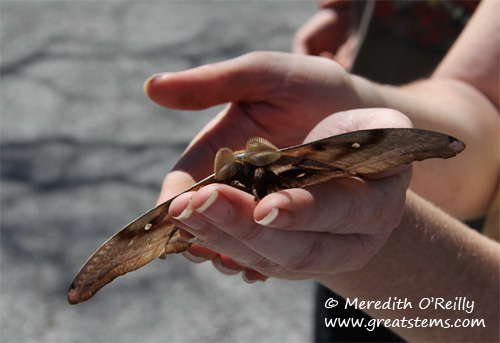 Polyphemus moths have an average wing span of about 6 inches. As adults, they also have reduced mouth parts, meaning that they can’t eat, so they have one job to focus on: reproduction. The feathery antennae of the males are used to detect the scent of unmated females. Whether the antennae also make the male moths look sexy to females, I cannot attest. But for this female, I think they look pretty cool. Not getting to eat means something else — the moths have a short lifespan of less than a week.
Polyphemus moths have an average wing span of about 6 inches. As adults, they also have reduced mouth parts, meaning that they can’t eat, so they have one job to focus on: reproduction. The feathery antennae of the males are used to detect the scent of unmated females. Whether the antennae also make the male moths look sexy to females, I cannot attest. But for this female, I think they look pretty cool. Not getting to eat means something else — the moths have a short lifespan of less than a week.
As it had trouble flying, It seemed to me that this little (big) moth was on its last wing, so to speak, so I gently kept it protected and decided to bring it home with us. As it turns out, the moth wasn’t as frail as we thought.
 Perhaps because it was darker in the car, the moth came to life once we got moving on the road. By the time we were on the highway, it was fluttering all about, making for quite an interesting drive home. At one point, the Polyphemus moth decorated my husband as a bowtie.
Perhaps because it was darker in the car, the moth came to life once we got moving on the road. By the time we were on the highway, it was fluttering all about, making for quite an interesting drive home. At one point, the Polyphemus moth decorated my husband as a bowtie.
For its own safety, we didn’t want to release the moth until we actually arrived home to our wooded habitat, but in the meantime, it kept us busy in the car, as we had to make sure it stayed safe there, too.
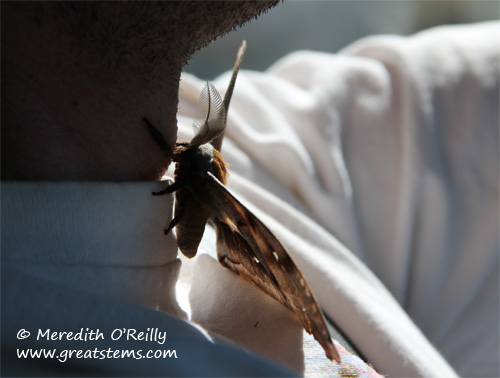 For quite a bit of the drive, the moth seemed particularly fond of my husband (who was under strict orders not to react to the tickling sensation, nor to panic and cause a wreck). My husband replied, “Finally, there’s an animal who’s not afraid of me!” How my husband manages to seem fearsome in our happy zoo is beyond me, but our skittish cat Cricket in particular still gives him the wary eye. Not many men can boast that they’ve had a Polyphemus moth rest on their Adam’s Apple, but my husband can. Let me just add that driving in a car with a fluttering giant silk moth is perhaps a “Don’t Try This
For quite a bit of the drive, the moth seemed particularly fond of my husband (who was under strict orders not to react to the tickling sensation, nor to panic and cause a wreck). My husband replied, “Finally, there’s an animal who’s not afraid of me!” How my husband manages to seem fearsome in our happy zoo is beyond me, but our skittish cat Cricket in particular still gives him the wary eye. Not many men can boast that they’ve had a Polyphemus moth rest on their Adam’s Apple, but my husband can. Let me just add that driving in a car with a fluttering giant silk moth is perhaps a “Don’t Try This at Home in Your Car” scenario.
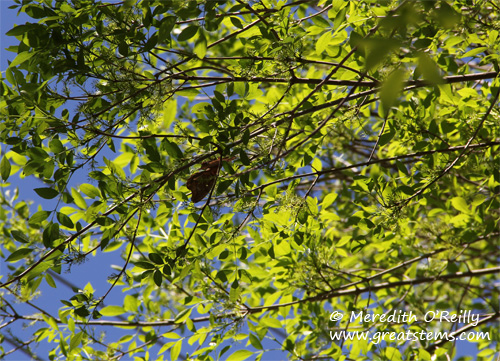 Upon our return home, I carefully gathered up the Polyphemus moth, bid it a fond farewell and good luck, and opened my hands to the sky. The moth flew up to the ash tree above, where it rested for much of the afternoon. What an adventure we all had!
Upon our return home, I carefully gathered up the Polyphemus moth, bid it a fond farewell and good luck, and opened my hands to the sky. The moth flew up to the ash tree above, where it rested for much of the afternoon. What an adventure we all had!
That moth is amazing! Unusual to see one at this time of year?
Actually, March is one of the months you are most likely to see this moth in our area, Alan. I felt very lucky!
I’m embarrassed to admit that I’m terrified of moths even though I think they’re pretty. I’m VERY glad there are people like you in the world! Thank you for rescuing the moth!
They are gorgeous. I saw two in my backyard and felt very lucky indeed. Never knew these moths could even be found in TX. I have a whole post devoted to this moth on my blog.
Wow, that moth had quite a day! Thanks for taking us along on your wonderful community service event, and the trip home with your new friend. Beautiful creature!
Your polyphemus are earlier there than here! Now I’m excited for silk moth season. We like to go out with a white bedsheet and shine lights on it to see what we find at night.
Your moth doesn’t look very beat up so it may have been newly emerged. Still, they don’t last long as adults. They have such cumbersome bodies that they are always sluggish when they’re cold. To get warm, they vibrate their wings… maybe that is what happened in the car!
Moths are gentle creatures and very valuable for the role they play in the ecosystem — I hope you’ll give them another chance!
It was comical, but that’s why I shared it — yet another one of our wildlife adventures!
It is possible, Eliza, but he didn’t look freshly emerged — he had some tattered marks, and when he flew, he really appeared to be struggling in a “my time is near” sense than a fresh, young moth testing its wings. It was also quite warm, bordering on hot, that day, so I don’t know how much temperature was a factor. Only the moth knows for sure!
I visited your post — you really captured the colorful beauty and spectacular eyespots of the Polyphemus moth. I want to find another one!
Damn that thing is huge!
Oh my, your husband gets a reward for not reacting to a large insect crawling on his neck while driving! Yes, it’s beautiful, but I’m not sure I could sit still under those conditions.
Truly huge, Katina — it was a challenge to keep it still in my hand, as it was too big for my hands!
I add it to our wildlife adventures, RobinL. It was rather amusing for my husband and me — the boys just kept reading their books in the backseat, however. Sorry for the delay in responding, Robin — we were on vacation!
Pingback: Making Ceramic Plant Markers | Great Stems
my son found a caterpillar of these today! in Portland Oregon of all places, love your photos, we’re debating whether we’re going to keep it over the winter or call the Zoo that has a nice butterfly/moth habitat.
Tough call! I’d be inclined to keep it at home, since you know there are host plants around and because the adults are so short-lived. They don’t eat as adult moths.
I’m glad you posted this. We’ve had one of these ladies hanging around our building. I’m sorry to say she may have gotten into some pesticides. I have been trying to identify her species.
We found one last night. I thought it was a little bird and I pulled over to get it off the road only to see that it was a huge moth. Brought it home (in my car also). We set it free and came in and looked it up to see what had found. Awesome moth.
Was your car ride as big an adventure as ours was, Shanna?